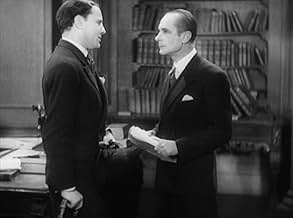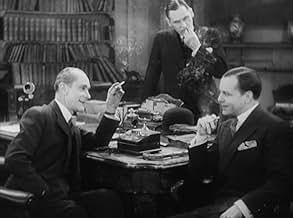Mary
- 1931
- 1 h 18 min
AVALIAÇÃO DA IMDb
5,7/10
1,1 mil
SUA AVALIAÇÃO
Adicionar um enredo no seu idiomaA juror in a murder trial, after voting to convict, has second thoughts and begins to investigate on his own before the execution.A juror in a murder trial, after voting to convict, has second thoughts and begins to investigate on his own before the execution.A juror in a murder trial, after voting to convict, has second thoughts and begins to investigate on his own before the execution.
- Direção
- Roteiristas
- Artistas
John Mylong
- John Stuart
- (as Jack Mylong-Münz)
Avaliações em destaque
This perfunctory German version of MURDER, filmed at the same time on the same sets but with a mostly different cast, is 28 minutes shorter than the English version! It leaves out all of the touches that make the English version enjoyable, and also leaves out some of the clues that lead to the murderer. Some of the things left out are: the jury member who hasn't a clue; the jury foreman having difficulty getting the ballots in the right piles; the jury filing out from the jury room into the court and Sir John waiting before getting up and joining them; the servant bringing the radio into the bathroom, and the colloquy with the servant at that point; the interior monologue is much shorter; dialogue in the scene immediately after is shorter (also, the bathroom and subsequent scene are sequenced wrong so that it seems he's shaving again after he finished); the landlady isn't present when the couple get the call from Sir John, and so the byplay about them owing the rent is not there; their frantic dressing and spiffing up for the Sir John visit; the shot of the stage manager's feet in a super-soft carpet, showing what it feels like to him; the scene where they look at the parlor with landlady is much shorter (and comes after scene where they look at her bedroom); tricking the landlady by using a high-pitched voice; Hitchcock's appearance in the street; tipping the theatre manager after they inspect the theatre; the scene with all the kids is much shorter, with the cat under the covers eliminated (same kids, though); the kids don't sit on the trunk, so the dialogue about the policeman's uniform in the trunk must not be there; the striking overhead shot of Mary in her cell, and the shadow of the noose; Sir John's scene with Mary is shorter, colder, and they don't talk about the theatre at the end; the scene of Sir John and the stage manager in the circus audience, where they talk about trapping the murderer with a Hamlet-like play is much shorter; when the murderer hangs himself, there's a somewhat more dramatic sound editing, perhaps to cover up the fact that he doesn't make a very good noose; the murderer carried out on a stretcher; the sequence of Sir John and Mary in the train is shorter; and the shot of the characters on stage at the end. Some of the jokes are still there but presented in so rudimentary a fashion that one would hardly notice. For example, when Sir John notices that his guest is using a small spoon for the soup, he does the same, and when he puts his martini olive on the tray, the guests don't know what to do with theirs; both these incidents still occur but with no reactions from the actors to point up the gags. Abel looks a lot like Marshall, which is very disconcerting because that British upper-class attitude that informs every aspect of the English version is completely lacking. The stage manager is an expressionless nonentity in this version. It's a second-hand, second-rate copy all through. One can hardly believe Hitchcock himself directed this totally lacking, colorless run-through of his delightful MURDER. You may never get a chance to see this one, which may frustrate Hitchcock completists, but, really, there's absolutely no reason to see it, even if you only understand German! See MURDER a second time instead.
It is late night when the dwellers of a street hear a scream in the apartment of the actress Mary Baring (Olga Tschechowa). A police officer arrives, and the neighbors see Mary dazed and confused, with blood on her clothes and on a poker, and the body of her colleague Ellen Moore on the floor. An empty bottle of brandy is on the table and Mary is in shock with no recollection of what happened. The drunken Mr. Moore says that Mary and Ellen were rivals in the theater and the police take Mary to the precinct. There is a trial, and the jurors believe Mary is guilty, but the famous actor Sir John Menier (Alfred Abel) believes she is not guilty. However, he is not able to change the position of the other jurors and is forced to change his vote to guilty. Mary is sentenced to the gallows, but Sir John decides to conduct his own investigation to prove that Mary is innocent.
"Mary" (1931) is a German spoken remake of "Murder!" (1930) that was shot simultaneously on the same sets of "Murder!" by Alfred Hitchcock with a German-speaking cast. The plot is interesting, about a murder and the woman accused and considered guilty by the jurors. There is one moment, when Sir John Menier exposes his opinion, that seems to be the inspiration to "12 Angry Men" (1957) when only one juror disagrees from the others. The real killer is a weird guy, wearing a dress to perform at the circus. After watching "Mary", I have finally finished to see or see again all the Alfred Hitchcock features and written a review in IMDb for each one. My vote is seven.
Title (Brazil): "Mary"
"Mary" (1931) is a German spoken remake of "Murder!" (1930) that was shot simultaneously on the same sets of "Murder!" by Alfred Hitchcock with a German-speaking cast. The plot is interesting, about a murder and the woman accused and considered guilty by the jurors. There is one moment, when Sir John Menier exposes his opinion, that seems to be the inspiration to "12 Angry Men" (1957) when only one juror disagrees from the others. The real killer is a weird guy, wearing a dress to perform at the circus. After watching "Mary", I have finally finished to see or see again all the Alfred Hitchcock features and written a review in IMDb for each one. My vote is seven.
Title (Brazil): "Mary"
For Hitchcock completists only, this German-language version of the same director's Murder! tells the same story on the same sets, but with different cast, as a juror questions the guilty verdict he helped come to.
A few mildly amusing visual flairs are present here: jurors seated around a circular table. The camera pans along and we see a first juror held deep in thought; the next several are listening with rapt attention; until we arrive at one man who is clearly bored to tears with it all; a mild joke which was thrown in to the German version, not in the UK version. Brief glimpses (again) of cross-dressing, which Hitch later went back to, in a big way, with Psycho.
Some early quick cuts are surprising, eleven cuts in a three seconds-long scene at the twenty three minute mark. Most unconventional at the time.
Overall the movie is watchable, but not very involving, partly at least due to its lax pacing, and a verbose screenplay. Like its UK counterpart, however, it does pick up for its memorable climax.
A few mildly amusing visual flairs are present here: jurors seated around a circular table. The camera pans along and we see a first juror held deep in thought; the next several are listening with rapt attention; until we arrive at one man who is clearly bored to tears with it all; a mild joke which was thrown in to the German version, not in the UK version. Brief glimpses (again) of cross-dressing, which Hitch later went back to, in a big way, with Psycho.
Some early quick cuts are surprising, eleven cuts in a three seconds-long scene at the twenty three minute mark. Most unconventional at the time.
Overall the movie is watchable, but not very involving, partly at least due to its lax pacing, and a verbose screenplay. Like its UK counterpart, however, it does pick up for its memorable climax.
Is it merely a German version of Hitchcock's "Murder!"? True both films are based on the same source-material. Yet the outcome is different. There is more emphasis on choice of camera and shots and editing in the German film than in the British one. The underlying cross dressing and gay aspects are more obvious in the German film. Yes "Mary'' can be considerably compared to Lumet's "12 Angry Men" made decades
later. Here the juror becomes the detective, while in Lumet's film the juror never really leaves the jury room. The relationship between juror and the accused is explored midway--a rare aspect in any jury-oriented tale. It is therefore goes one up on "Murder!" Further, Alfred Abel (a German actor) is superior to Herbert Marshall both playing the same character of the same tale, that of Sir John Menier. So is Olga Tschechowa playing the role of the accused actress, facing death sentence.
If you only speak German, you should watch this version. If you speak English, you should just watch Alfred Hitchcock's film Murder! (1930) because it's exact same movie, using the exact same sets and plot, just with different actors.
Você sabia?
- CuriosidadesA copy of the film is included as a bonus feature on the Kino Lorber Studio Classics DVD and German DVD releases of Assassinato (1930) and the French DVD release of A Estalagem Maldita (1939).
- Erros de gravaçãoAs Sir John interviews Mary in jail, it is established in long-shot that both are sitting at opposite ends of a long table. During frontal closeups, the widths of the planks that make up the tabletop reveal that very randomly either the table is turning between shots or both persons repeatedly switch places.
The exact same continuity error also applies to the American version of the movie, Assassinato (1930).
- ConexõesAlternate-language version of Assassinato (1930)
Principais escolhas
Faça login para avaliar e ver a lista de recomendações personalizadas
Detalhes
- Data de lançamento
- Países de origem
- Idioma
- Também conhecido como
- Secreto de la noche
- Locações de filme
- Empresa de produção
- Consulte mais créditos da empresa na IMDbPro
- Tempo de duração
- 1 h 18 min(78 min)
- Cor
- Proporção
- 1.20 : 1
Contribua para esta página
Sugerir uma alteração ou adicionar conteúdo ausente































